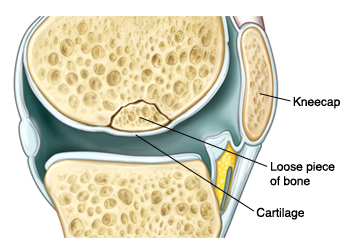When Your Child has Osteochondritis Dissecans (OCD)
When Your Child Has Osteochondritis Dissecans
Your child has been diagnosed with osteochondritis dissecans (OCD). This occurs when a small piece of bone and cartilage in a part of a joint separates from the bone around it. OCD is most common in the knee joint, but it can happen in other joints such as the elbow and ankle. The condition can be mild, moderate, or severe.

-
Mild OCD: A piece of bone has begun to separate from the joint, but this piece is still firmly held in place by a covering of cartilage (dense elastic tissue that helps cushion the joint).
-
Moderate OCD: The piece of bone separates more. The covering of cartilage may tear.
-
Severe OCD: The piece of bone and covering of cartilage become loose and “float around” in the joint.
Your child may see an orthopedist (doctor specializing in treating bone and joint problems) for evaluation and treatment of his or her joint.
What are the causes of osteochondritis dissecans?
It is not entirely known why some children develop OCD. What is known:
-
The separation of bone from the joint may be due to loss of blood supply to that piece of bone.
-
Overuse of the joint and repeated stress (from jumping or running, for example) make a child more likely to develop OCD.
-
Children who are athletes develop OCD more often than non-athletes.
-
OCD is most common in boys between the ages of 10 to 16.
-
OCD may run in families.
What are the signs and symptoms of osteochondritis dissecans?
Common signs and symptoms of OCD include:
-
Soreness of the joint
-
Swelling of the joint that can sometimes come and go
-
Pain when the joint is used, but children sometimes have trouble identifying where the pain is
-
Stiffness of the joint when it’s not being used
-
Feeling that the joint is “locking up” or “catching”
-
Limping (if the knee or ankle is affected)
How is osteochondritis dissecans diagnosed?
The doctor will ask about your child’s health history and symptoms. If OCD is suspected, an X-ray will be done. In some cases, a test called an MRI (magnetic resonance imaging) may also be done. During this test, strong magnets and radio waves are used to create a picture of the inside of the joint.
How is osteochondritis dissecans treated?
The goal of treatment for OCD is to heal the joint. The separated piece of bone and cartilage need to heal back onto the joint. This healing takes time, often up to 6 months. During this time:
-
Relieve symptoms to help make your child more comfortable.
-
Ice the joint as needed for pain. This should be done for no more than 15 minutes at a time. Use an ice pack or bag of frozen peas wrapped in a thin towel. Never place ice directly on your child's skin.
-
If told to by your child’s doctor, have your child take NSAIDs (nonsteroidal anti-inflammatory drugs). NSAIDs include ibuprofen and naproxen. Give these medicines to your child only as directed.
-
-
Have the child rest the joint to allow it to heal.
-
Have your child stop any activity that causes pain. Avoid running and jumping.
-
If prescribed by the doctor, have your child use crutches to lessen stress on the knee or ankle joint.
-
If prescribed by the doctor, have your child wear a brace or cast on the joint. A brace or cast keeps the joint still to help with healing.
-
If prescribed by the doctor, physical therapy to improve strength, mobililty, and flexibility
-
-
In severe cases, the doctor may recommend surgery.
-
During surgery, a pin may be put into the loose piece of bone to secure it to the rest of the joint. Or, the loose piece of bone is removed.
-
After surgery, your child will use crutches for 1 to 3 months to allow the joint to heal.
-
What are the long-term concerns?
With treatment, OCD often heals well. If the lesion doesn’t heal, the child may develop joint pain that doesn’t go away. An adult who had OCD as a child may be more likely to develop arthritis. Your child’s doctor can tell you more about this.
Updated:
March 15, 2019
Reviewed By:
Bass, Pat F. III, MD, MPH,Joseph, Thomas N., MD